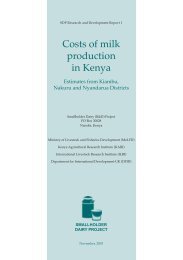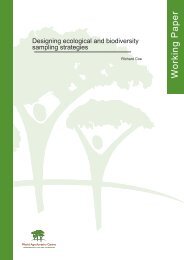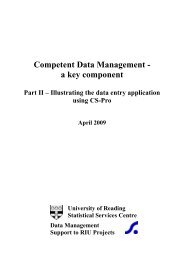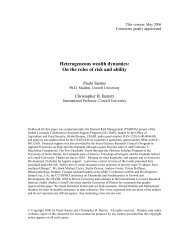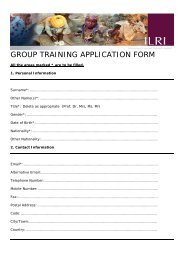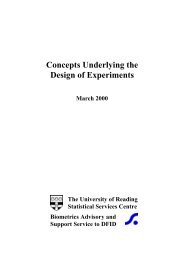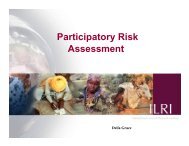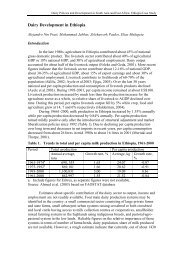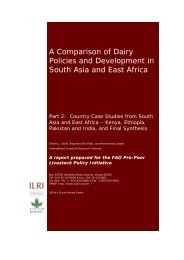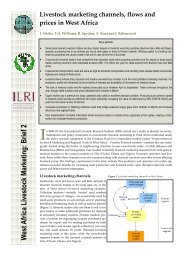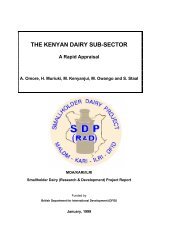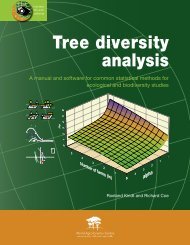There is a strong desire amongst government <strong>of</strong>ficials and researchers to encourage more <strong>in</strong>tensive use<strong>of</strong> the land under rubber and oil palm. Integration <strong>of</strong> rum<strong>in</strong>ants has been identified as the best way to achievethis objective. There are three <strong>in</strong>terrelated factors that prevent more widespread adoption <strong>of</strong> <strong>in</strong>tegratedperennial tree crop–rum<strong>in</strong>ant systems. Firstly, the availability <strong>of</strong> more lucrative jobs <strong>in</strong> the non-agriculturalsector has created a serious labour shortage <strong>in</strong> the rural areas. Smallholders have left their farms <strong>in</strong> favour <strong>of</strong>jobs <strong>in</strong> the manufactur<strong>in</strong>g and service sectors. Only men and women over 50 years <strong>of</strong> age are left on the farmsto take care <strong>of</strong> the animals. The country has become more and more dependent on migrant labour from othercountries such as Bangladesh. This has posed serious problems for farms us<strong>in</strong>g such labour; wages are highand the costs <strong>of</strong> search<strong>in</strong>g for labour are also <strong>in</strong>creas<strong>in</strong>g. Secondly, the private sector, presently engaged <strong>in</strong>large-scale rubber and oil palm production, is not keen on <strong>in</strong>tegrat<strong>in</strong>g livestock <strong>in</strong>to the plantations becausethe benefits are not sufficiently attractive to adopt the system. Labour shortages further exacerbate theproblem. The government should consider giv<strong>in</strong>g fiscal <strong>in</strong>centives to promote the <strong>in</strong>tegration <strong>of</strong> animals withplantation agriculture. This would <strong>in</strong>crease value-added products from a given land area, and also <strong>in</strong>creasethe level <strong>of</strong> sufficiency for rum<strong>in</strong>ants. At present, government programmes for promot<strong>in</strong>g crop–animal<strong>in</strong>tegration are concentrat<strong>in</strong>g on smallholders on the plantations <strong>of</strong> the Federal Land Consolidation andRehabilitation Authority (FELCRA) and FELDA. Two other government agencies, the Department <strong>of</strong>Veter<strong>in</strong>ary Services and the Malaysian Agricultural Research and Development Institute (MARDI), are also<strong>in</strong>volved <strong>in</strong> this programme. However, given high economic growth rates, <strong>in</strong>tensive commercial production<strong>of</strong> rum<strong>in</strong>ants may become more important, based primarily on the use <strong>of</strong> available crop residues and AIBP.Lastly, Malaysia imports a significant amount <strong>of</strong> beef from India and live animals from Australia, at somecost to foreign exchange reserves. S<strong>in</strong>ce there is no guarantee that this situation will cont<strong>in</strong>ue <strong>in</strong>def<strong>in</strong>itely,despite the lack <strong>of</strong> trade restrictions under the General Agreement on Trade and Tariffs (GATT) agreement,the challenge lies <strong>in</strong> improv<strong>in</strong>g the efficiency and cost-effectiveness <strong>of</strong> the predom<strong>in</strong>antly small-scale cattleand sheep farms.MyanmarEnvironment and cropp<strong>in</strong>g systemsF<strong>in</strong>d<strong>in</strong>g published data on AEZs and cropp<strong>in</strong>g systems has been extremely difficult . With the exception <strong>of</strong>some statistics on rice from the IRRI <strong>of</strong>fice <strong>in</strong> Yangon, one has had to conclude that detailed <strong>in</strong>formation <strong>of</strong>the nature collected <strong>in</strong> the other countries is either not available or the authorities were reluctant to releasesuch <strong>in</strong>formation to outsiders for political reasons.Myanmar lies between latitudes 9–28° North, with a total land area <strong>of</strong> about 676,756 km 2 (Anon 1996a).The western, northern and eastern parts <strong>of</strong> the country are hilly regions covered <strong>in</strong> forest, with altitudes <strong>of</strong>915–2134 m. There are five zones which are designated as coastal, delta, dry, northern and mounta<strong>in</strong>.Myanmar possesses both tropical and sub-tropical climates with two dist<strong>in</strong>ct wet and dry seasons. Ra<strong>in</strong>falls between mid-May and mid-October. The coast and mounta<strong>in</strong>s receive the heaviest annual ra<strong>in</strong>falls <strong>of</strong>2540–5080 mm. In the dry central parts, the ra<strong>in</strong>fall is 762–1016 mm annually. The daily maximumtemperatures are 40.6–43.3°C <strong>in</strong> the dry central parts dur<strong>in</strong>g the hot season, whilst the daily maximumtemperatures are 10–15.6°C <strong>in</strong> the cool season. Temperatures are lower <strong>in</strong> the mounta<strong>in</strong>s where the averagedaily maximum is 29.4°C and the m<strong>in</strong>imum 7.2°C.The country is divided <strong>in</strong>to seven states and seven divisions. Soils vary depend<strong>in</strong>g on climate,topography and location. The soils are grouped texturally <strong>in</strong>to loamy alluviums (50%), clays (30%) and sands(20%). Detailed soil classification data are not available, but reference to FAO maps <strong>in</strong>dicates that some 11groups are found, <strong>of</strong> which ultisols, <strong>in</strong>ceptisols and oxisols are common. Out <strong>of</strong> a total land area <strong>of</strong> 68 millionha, 19 million ha are potentially cultivable, 32 million ha are <strong>in</strong> forest and 17 million ha are unclassified.Only 8.5 million ha are actually cultivated.Over 60 different crops are grown <strong>of</strong> which 22 are economically important. Rice is the dom<strong>in</strong>ant crop,and is grown on 4.9 million ha, nearly 60% <strong>of</strong> the land area under cultivation (IRRI 1995b). Approximately62% <strong>of</strong> the rice crop is ra<strong>in</strong>fed lowland, 14% irrigated, 11% deep water, 4% upland with the rema<strong>in</strong>der grownon problem soils or terraces, or classified as ‘late-some’. Two-thirds <strong>of</strong> the rice crop is grown <strong>in</strong> the deltas
<strong>of</strong> the Ayeyarwady and Sittang rivers, and another 17% <strong>in</strong> the coastal zone. Average rice yields <strong>in</strong> the deltazones are 3.3 t/ha compared to the national average <strong>of</strong> 3 t/ha.In terms <strong>of</strong> sown area, the second most important crop <strong>in</strong> the country is sesame. Other crops <strong>of</strong>importance <strong>in</strong>clude peanut, sunflower, grambean, pigeon pea, chickpea, cowpea and maize. Of the <strong>in</strong>dustrialand plantation crops, cotton and fruit are the most important. Various vegetables are grown by smallholders.In the uplands, potato is grown as a cash crop. However, none <strong>of</strong> these crops <strong>in</strong>dividually exceeds more than12% <strong>of</strong> the planted area, which emphasises the importance <strong>of</strong> rice.Rice followed by fallow is the traditional cropp<strong>in</strong>g system, and rice is grown as a s<strong>in</strong>gle wet seasoncrop. In the southern and central regions chili, mungbean, peanut or pigeon pea are <strong>of</strong>ten sown after the ricecrop. In certa<strong>in</strong> areas, sesame is sown before the rice crop is planted.Shift<strong>in</strong>g cultivation is practised <strong>in</strong> the north-east <strong>of</strong> Shan State. Fallow periods <strong>of</strong> up to seven years havebeen reduced to two years due to <strong>in</strong>creases <strong>in</strong> human population pressure, with correspond<strong>in</strong>g problems <strong>of</strong>soil erosion. There is no evidence that, as <strong>in</strong> Vietnam and the Lao PDR, the government is try<strong>in</strong>g to elim<strong>in</strong>atethis system.IRRI opened an <strong>of</strong>fice <strong>in</strong> Myanmar <strong>in</strong> 1990, and has been <strong>in</strong>volved <strong>in</strong> germplasm conservation, varietalimprovement, agricultural mechanisation, tra<strong>in</strong><strong>in</strong>g and farm<strong>in</strong>g systems research. In addition, Myanmar hasbeen <strong>in</strong>volved <strong>in</strong> the Asian Rice Farm<strong>in</strong>g <strong>Systems</strong> Network (ARFSN). Pre- and post-rice test<strong>in</strong>g <strong>in</strong> the uplandshas led to the release <strong>of</strong> varieties <strong>of</strong> peanut, soyabean, rice, sorghum, mungbean and cowpea. Sesbaniarostrata has been tested as a green manure crop and rice-aquaculture systems are be<strong>in</strong>g developed.<strong>Animal</strong> resourcesThe animal resources <strong>in</strong>clude both rum<strong>in</strong>ants (buffaloes, cattle, goats and sheep) and non-rum<strong>in</strong>ants (pigs,poultry and ducks). The most recent <strong>of</strong>ficial statistics (1995–1996) <strong>in</strong>dicate the presence <strong>of</strong> 10.1 million cattle,2.2 million buffaloes, 1.5 million goats and sheep, 2.9 million pigs, 30 million chicken and five million ducks(AHVD 1996). It is estimated that 95% <strong>of</strong> these resources are reared by smallholders. Currently, 75% <strong>of</strong> thetotal prote<strong>in</strong> <strong>in</strong>take comes from fish compared to 20% from animals.Buffaloes are concentrated ma<strong>in</strong>ly <strong>in</strong> Shan and Saga<strong>in</strong>g states and <strong>in</strong> the Ayeyarwady, Bago and Rakh<strong>in</strong>edivisions. In the delta areas, they are used for land preparation <strong>in</strong> rice cultivation. Both swamp and river typesare found, the latter be<strong>in</strong>g <strong>in</strong>troduced from India for milk production.Cattle are the most important rum<strong>in</strong>ants and populations are concentrated <strong>in</strong> the ra<strong>in</strong>fed lowlands and uplands<strong>in</strong> Saga<strong>in</strong>g state, and <strong>in</strong> the Mandalay, Magway and Bajo divisions. Beef is unimportant <strong>in</strong> this Buddhist country,and is only a by-product when the animals are slaughtered at the end <strong>of</strong> their work<strong>in</strong>g lives at 16 years <strong>of</strong> age.About 58% <strong>of</strong> the national herd is used for draft power. Only males are used for land preparation as the femalesare kept for breed<strong>in</strong>g. Approximately 60% <strong>of</strong> the beef cattle are considered <strong>in</strong>digenous (e.g. Pya Ze<strong>in</strong>g and ShweNi), whilst the rema<strong>in</strong><strong>in</strong>g animals are crossbreds based on imported Bos <strong>in</strong>dicus blood from India.Indigenous cattle are preferred to crossbreds for draft power. Prelim<strong>in</strong>ary studies suggest that, althoughlocal breeds generate a relatively lower amount <strong>of</strong> draft power compared to crossbred cattle, they have morestam<strong>in</strong>a and are able to provide power over a longer period <strong>of</strong> time. These animals are also adapted to localconditions. Extensive field visits <strong>in</strong> the Bago Division supported this conclusion. Farmers were observed us<strong>in</strong>g<strong>in</strong>digenous cattle for land preparation for up to 10 hours a day <strong>in</strong> two shifts <strong>in</strong> the early morn<strong>in</strong>g and late afternoon.Dairy cattle production is <strong>in</strong>creas<strong>in</strong>g <strong>in</strong> importance, and several exotic breeds such as Holste<strong>in</strong>-Friesian,Jersey and Ayrshire have been imported from Australia, and the Sahiwal and Red S<strong>in</strong>dhi from the Indiansub-cont<strong>in</strong>ent. In addition, frozen semen <strong>of</strong> improved breeds has been imported from North America andEurope. Two state farms currently supply breed<strong>in</strong>g bulls to smallholders. Private farms also exist and varyfrom those with 30–100 animals to smallholder farms with 4–15 animals each.The National Plann<strong>in</strong>g and Economic Development Plan (1996–2001) aims to <strong>in</strong>crease annually thenumbers <strong>of</strong> draft cattle by 100,000 and dairy cattle by 33,000. The plan also envisages <strong>in</strong>creases <strong>in</strong> thepopulation for milk, meat and draft power.
- Page 2 and 3:
Affiliation of Authors:Dr C. Devend
- Page 4 and 5:
6.Strategyfor researchJustification
- Page 7 and 8:
AcknowledgementsThe International L
- Page 9 and 10:
esearch opportunities appropriate t
- Page 11 and 12:
Table 1.Animal populations and meat
- Page 13 and 14:
Introduction2. Characterisation and
- Page 15 and 16:
Figure 2. Sub-humid tropics and sub
- Page 17 and 18:
Table 3.Human and animal population
- Page 19 and 20:
Table 5. Rice-growing environments
- Page 21 and 22:
Multiple upland annual crop systems
- Page 23 and 24:
Table 6. Continued.Country Importan
- Page 25 and 26:
It should be noted that, compared w
- Page 27 and 28: Table 8.CountryCambodiaChinaIndones
- Page 29 and 30: of non-renewable fossil fuels and t
- Page 31 and 32: Overview of researchThere was a sur
- Page 33 and 34: • Identification of alternative c
- Page 35 and 36: Various animal production systems t
- Page 37 and 38: Presently, much of the vegetable pr
- Page 39 and 40: Table 10. Summary of the main socio
- Page 41 and 42: Table 11. Institutions and organisa
- Page 43 and 44: 3. In the ASEAN sub-region, inadequ
- Page 45 and 46: Table 12. Continued.SituationsPract
- Page 47 and 48: 6. Strategy for researchJustificati
- Page 49 and 50: Table 13. Priorities for research a
- Page 51 and 52: VietnamResearch capacity in NARS is
- Page 53 and 54: CRIFC (Central Research Institute f
- Page 55 and 56: IAS. 1995. Proceedings of the Works
- Page 57 and 58: Systems of sub-Saharan Africa. Volu
- Page 59 and 60: or waterlogged in the wet season an
- Page 61 and 62: Table A1. Important diseases of ani
- Page 63 and 64: • Increased cropping intensities,
- Page 65 and 66: the animal output came from pigs al
- Page 67 and 68: 18-21° North, with an average rain
- Page 69 and 70: In the Nusa Tenggara islands, signi
- Page 71 and 72: Women work 11.5 h/day on average co
- Page 73 and 74: Various Australian forage projects
- Page 75 and 76: village production systems; to stud
- Page 77: The availability of feed in rubber
- Page 81 and 82: Constraints and opportunitiesInadeq
- Page 83 and 84: gaining in importance, and signific
- Page 85 and 86: Table A3. Characterisation of crop-
- Page 87 and 88: Table A4. Interventions in crop-ani
- Page 89 and 90: Table A4. Continued.Project TitleGo
- Page 91 and 92: otations are practised, and there a
- Page 93 and 94: such as abortion. Vaccination cover
- Page 95 and 96: large areas of forests (3.4 million
- Page 97 and 98: Table A6. Some animal diseases repo
- Page 99 and 100: Appendix IIItineraryThe Philippines
- Page 101 and 102: 26 November 1996 am Visit to small
- Page 103 and 104: Appendix IIIList of persons metPhil
- Page 105 and 106: Mr Chhiv Nan, Acting Director, Depa
- Page 107 and 108: Dr U Maung Ngint, Managing Director
- Page 109: List of acronymsAARDACIARADBAEZAIBP



